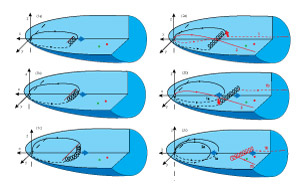2012 ARTEMIS SCIENCE NUGGETS
SUMMARIES OF ARTEMIS RESEARCH
| <<View 2011 ARTEMIS Nuggets |
 Jonathan P. Eastwood, October 2012
Jonathan P. Eastwood, October 2012Survival of flux transfer event (FTE) flux ropes far along the tail magnetopause
ARTEMIS and THEMIS, working in tandem, have revealed new insights into how the solar wind enters the Earth’s magnetosphere, finding lumps of plasma material propagating for nearly half a million kilometres along the edge of the magnetosphere’s tail. Read more.
 A.R. Poppe, August 2012
A.R. Poppe, August 2012ARTEMIS observations of pick-up ions in the terrestrial magnetotail lobes
The ARTEMIS P2 probe has observed freshly-produced ions above the lunar surface while deep in Earth’s magnetotail, suggesting an ion source from the Moon itself. Read more.
 J. S. Halekas, May 2012
J. S. Halekas, May 2012Lunar Pickup Ions Observed by ARTEMIS
These impacts release atoms from the lunar surface, with some emitted as charged ions, and others emitted in neutral form, with many of the latter subsequently ionized by photo-ionization and other processes. Read more.
 S. Kiehas, April 2012
S. Kiehas, April 2012Formation of tilted flux ropes in the Earth's magnetotail observed with ARTEMIS.
ARTEMIS spacecraft observe tilted flux ropes near lunar orbit and a progressive increase in their propagation speed. Read more.
 J. S. Halekas, April 2012
J. S. Halekas, April 2012Lunar Precursor Effects in the Solar Wind and Terrestrial Magnetosphere
Contrary to the simple view of the Moon as a simple absorber of the flowing solar wind plasma, recent ARTEMIS observations show a host of plasma effects extending ~10,000 km or more upstream from the Moon. Read more.
 J.B. Tao, February 2012
J.B. Tao, February 2012Kinetic instabilities in the lunar wake: ARTEMIS observations
This paper presents interferometric analyses and Vlasov simulations of high frequency (close to electron plasma frequency) electrostatic waves observed during the first lunar wake flyby of the ARTEMIS P1 spacecraft. Read more.
 A. R. Poppe, January 2012
A. R. Poppe, January 2012A comparison of ARTEMIS measurements and plasma modeling of the lunar electrostatic surface charge.
ARTEMIS data is compared to a particle-in-cell plasma model in order to determine how the lunar surface charges in response to ambient electrical currents. Read more.
 Please send comments/suggestions to
Emmanuel Masongsong / emasongsong@igpp.ucla.edu
Please send comments/suggestions to
Emmanuel Masongsong / emasongsong@igpp.ucla.edu